|
|
2016年, 第3卷, 第2期 刊出日期:2016-04-01
|
上一期
下一期 |
|
|
|
|
|
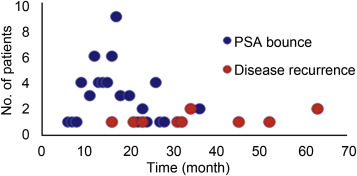
Prostate specific antigen bounce after intensity-modulated radiation therapy in an Asian population
Yu Guang Tan, Weber Lau Kam On, Hong Hong Huang, Terence Tan Wee Kiat
Asian Journal of Urology, 2016, 3(2): 59-63.
doi:10.1016/j.ajur.2015.12.001
 摘要
摘要
(
504 )
 PDF
PDF (743KB)
(
343
)
Objective: Serum prostate specific antigen (PSA) is commonly used to evaluate treatment response after definitive radiation therapy (RT). However, PSA levels can temporarily rise without a clear reason, termed "PSA bounce", and often engender great anxiety for both patients and physicians. The present study aimed to determine the prevalence and factors that predict "PSA bounce" after intensity-modulated radiation therapy (IMRT), and the relevance to biochemical failure and cancer recurrence in an Asian population.
Methods: We retrospectively reviewed 206 patients who received IMRT for prostate cancer from 2004 to 2012 in the National Cancer Centre Singapore. These patients were followed up with regular PSA monitoring. We defined "PSA bounce" as a rise of 0.1 ng/mL, followed by two consecutive falls. Patients with biochemical failure (PSA nadir + 2 ng/mL) were further evaluated for cancer recurrence.
Results: Sixty-one patients (29.6%) experienced "PSA bounce", at a median time of 16 months and lasted for 12 months. Age remained the most consistent predictor of the incidence, duration and extent of "PSA bounce". Other contributory factors included baseline PSA, Gleason score and PSA nadir. Hormonal therapy and prostate volume did not affect this phenomenon. Sixteen patients (7.8%) developed biochemical recurrence, at median time of 32 months, of which 11 were confirmed to have metastatic disease. The median follow-up time was 71 months.
Conclusion: A younger age predicts PSA bounce incidence, duration and magnitude. The extent of bounce appears to be lower in Asian population. The interval to occurrence and extent of PSA elevation separates PSA bounce from disease recurrence.
参考文献 |
相关文章 |
计量指标
|
|
|
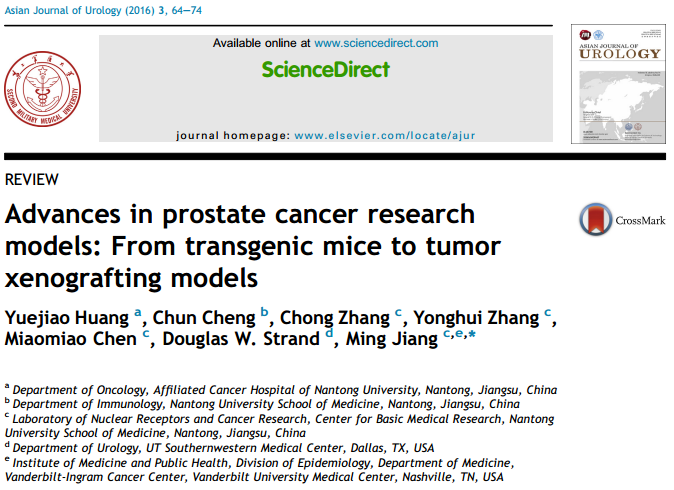
Advances in prostate cancer research models: From transgenic mice to tumor xenografting models
Yuejiao Huang, Chun Cheng, Chong Zhang, Yonghui Zhang, Miaomiao Chen, Douglas W. Strand, Ming Jiang
Asian Journal of Urology, 2016, 3(2): 64-74.
doi:10.1016/j.ajur.2016.02.004
 摘要
摘要
(
495 )
 PDF
PDF (463KB)
(
595
)
The identification of the origin and molecular characteristics of prostate cancer (PCa) has crucial implications for personalized treatment. The development of effective treatments for PCa has been limited; however, the recent establishment of several transgenicmouse lines and/or xenografting models is better reflecting the disease in vivo. With appropriate models, valuable tools for elucidating the functions of specific genes have gone deep into prostate development and carcinogenesis. In the present review, we summarize a number of important PCa research models established in our laboratories (PSA-Cre-ERT2/PTEN transgenic mouse models, AP-OX model, tissue recombination-xenografting models and PDX models), which represent advances of translational models from transgenic mouse lines to human tumor xenografting. Better understanding of the developments of these models will offer new insights into tumor progression and may help explain the functional significance of genetic variations in PCa. Additionally, this understanding could lead to new modes for curing PCa based on their particular biological phenotypes.
参考文献 |
相关文章 |
计量指标
|
|
|
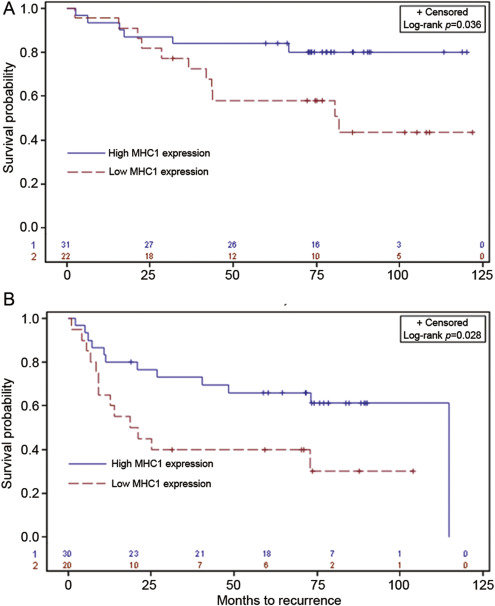
Major histocompatibility complex I upregulation in clear cell renal cell carcinoma is associated with increased survival
Rishi R. Sekar, Claire M. De La Calle, Dattatraya Patil, Sarah A. Holzman, Yoram Baum, Umer Sheikh, Jonathan H. Huang, Adeboye O. Osunkoya, Brian P. Pollack, Haydn T. Kissick, Kenneth Ogan, Viraj A. Master
Asian Journal of Urology, 2016, 3(2): 75-81.
doi:10.1016/j.ajur.2016.02.001
 摘要
摘要
(
411 )
 PDF
PDF (1093KB)
(
446
)
Objective: To examine the prognostic value of tumor major histocompatibility complex I (MHCI) expression on survival and recurrence in patients with clear cell renal cell carcinoma (RCC).
Methods: Fifty-three patients that underwent nephrectomy at our institution for clear cell RCC (T1-T3) with ≥ 4 years of follow-up were queried from our nephrectomy database. Immunohistochemical staining for MHCI was performed on tumor specimens and MHCI expression was quantified with an automated image analysis technique. Patients were divided into high and low MHCI expression groups in order to study the relationship between MHCI expression and prognosis using the Kaplan-Meier method and log-rank test.
Results: Overall survival and recurrence free survival were increased in the high MHCI expression group compared to the low MHCI expression group (log-rank, p=0.036 and p=0.028, respectively). Patients alive at the end of the study had higher MHCI expression (mean positivity score 0.82) than those that died of disease (mean positivity score 0.76, t test, p=0.030). Patients that did not develop recurrence during the study period had higher MHCI expression (mean positivity score 0.83) than those that did develop recurrence (mean positivity score 0.78), but this difference was not significant (t test, p=0.079).
Conclusion: Our data demonstrate that high MHCI expression confers improved overall and recurrence free survival in patients with clear cell RCC and could serve as an important prognostic tool in identifying high-risk patients.
参考文献 |
相关文章 |
计量指标
|
|
|
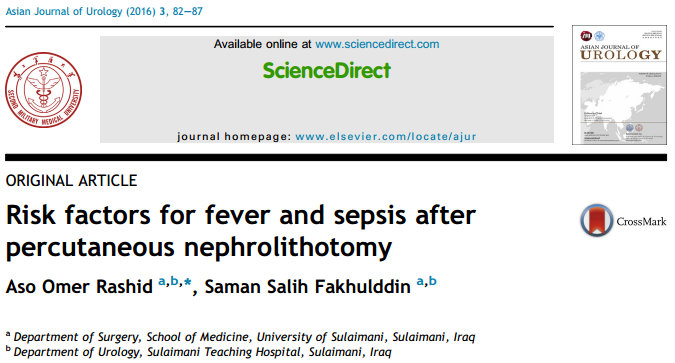
Risk factors for fever and sepsis after percutaneous nephrolithotomy
Aso Omer Rashid, Saman Salih Fakhulddin
Asian Journal of Urology, 2016, 3(2): 82-87.
doi:10.1016/j.ajur.2016.03.001
 摘要
摘要
(
602 )
 PDF
PDF (414KB)
(
928
)
Objective: Percutaneous nephrolithotomy (PCNL) is commonly used in the management of large renal stones. Postoperative infections are one of the most common complications of this procedure. The present study is to determine and assess the factors that may increase the risk to develop fever and urinary sepsis after PCNL.
Methods: A total of 60 patients (38 males and 22 females) with a mean age of 40.25 years enrolled in this study in Sulaimania Teaching Hospital. Patients had renal stone disease need operation with different socioeconomic status, body mass index and different type and size of stones were included in this study. Patients with preoperative positive urine culture and sensitivity were excluded. Preoperative investigations done for all patients. All Patients received prophylactic antibiotic gentamicin intravenously at the induction of anaesthesia. Renal pelvis urine sample were taken from all patients after puncturing the pelvicalyceal system and send for culture and sensitivity. Patients were monitored closely in the postoperative period for the development of fever and sepsis.
Results: Mean duration of the operations was 77.08 min ranged 40-120 min. All patients had postoperative nephrostomy tube. Seventeen (28.33%) patients developed post PCNL fever and the statistically significant factors for post PCNL fever were diabetes mellitus (DM) (p=0.001), stone burden (p=0.001), number of the stones (p < 0.001), degree of hydronephrosis (p=0.001), duration of the operation (p < 0.001), residual stones (p=0.001) and number of tracts (p=0.038). Three (5.00%) patients developed post PCNL sepsis, and the statistically significant risk factors for post PCNL sepsis were duration of the operation (p=0.013) and intraoperative blood loss, postoperative drop in haemoglobin (HB) level (p=0.046).
Conclusion: DM, staghorn stones, degree of hydronephrosis, duration of the operation and number of tracts are risk factors for post PCNL fever, while number of stones, intraoperative blood loss, duration of the operation and residual stones are risk factors for post PCNL sepsis.
参考文献 |
相关文章 |
计量指标
|
|
|
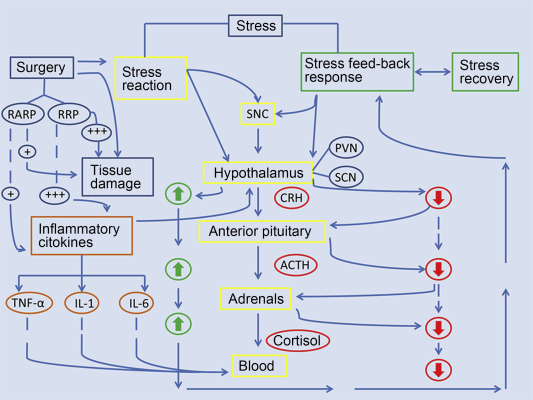
Robotic assisted radical prostatectomy accelerates postoperative stress recovery: Final results of a contemporary prospective study assessing pathophysiology of cortisol peri-operative kinetics in prostate cancer surgery
Antonio B. Porcaro, Nicolò de Luyk, Paolo Corsi, Marco Sebben, Alessandro Tafuri, Davide Inverardi, Davide De Marchi, Irene Tamanini, Matteo Brunelli, Maria Angela Cerruto, Gian Luca Salvagno, Gian Cesare Guidi, Walter Artibani
Asian Journal of Urology, 2016, 3(2): 88-95.
doi:10.1016/j.ajur.2016.03.002
 摘要
摘要
(
434 )
 PDF
PDF (2102KB)
(
505
)
Objective: To investigate the effects of prostate cancer (PCa) surgery on the stress system and to identify potential independent factors associating with stress recovery.
Methods: The design of the study was prospective and PCa surgery included robot assisted radical prostatectomy (RARP) or retropubic radical prostatectomy (RRP). Between February 2013 to December 2014, 315 consecutive patients were evaluated. The effects of PCa surgery on the stress system were measured by cortisol serum levels before and after surgery on postoperative day (POD) 0, 1, 3, 5 and 45. Cortisol variations in the population and subpopulation (RARP vs. RRP) of patients were investigated by statistical methods. Factors associating with stress recovery were assessed by simple linear regression (SLR) and multiple linear regression (MLR) analysis.
Results: RARP was performed in 75.9% of cases. In the patient population, there were wide serum cortisol perioperative variations. PCa surgery triggered the stress system which immediately (POD 0) responded by cortisol overproduction which induced the negative feedback mechanism that started on POD 1, continued on POD 3, was still ongoing on POD 5 and completely settled on POD 45 (stress recovery). In the subpopulation of patients, significantly lower cortisol serum levels were detected on POD 3-5 in RARP cases inwhomcortisol levels were close to preoperative levels (stress recovery) on POD 5. Independent predictive factors of serum cortisol on POD 5 (stress recovery) were preoperative cortisol (p=0.02), cortisol levels on POD 3 (p < 0.0001) and RARP (p=0.03) in which the association was negative (stress recovery faster than RRP).
Conclusion: Our study shows that PCa surgery immediately (POD 0) triggers the stress system which respond by overproduction of cortisol which induces the negative feedback mechanism that starts on POD 1, is still ongoing on POD 5, but is completely settled on POD 45. Moreover, after surgical trauma, our study gives evidence that the RARP procedure associates with stress recovery faster than RRP. Further confirmatory studies are required.
参考文献 |
相关文章 |
计量指标
|
|
|
Glass ampoule in urinary bladder as a foreign body
Naloh Mibang, Mohammad Shazib Faridi, Md Jawaid Rahman, Nameirakpam Shantajit, Renthlei Lalrammuana, Khumukchum Somarendra
Asian Journal of Urology, 2016, 3(2): 96-98.
doi:10.1016/j.ajur.2016.01.001
 摘要
摘要
(
413 )
 PDF
PDF (1866KB)
(
438
)
A wide range of objects have been inserted into the urinary bladder and urethra. Most foreign bodies in the lower genitourinary tract are self-inserted via the urethra as the result of erotic impulses, psychometric problems, sexual curiosity, or sexual practice while intoxicated. Here we report the case of a 32-year-old female with alleged history of insertion of glass ampoule in the urethra by the husband in eroticism which was removed with open surgery. This is the first case of its kind as per the literature available.
参考文献 |
相关文章 |
计量指标
|
|
|
Pediatric fibrous pseudotumor of the tunica vaginalis testis
Ryan Yu, Jefferson Terry, Mutaz Alnassar, Jorge Demaria
Asian Journal of Urology, 2016, 3(2): 99-102.
doi:10.1016/j.ajur.2016.02.003
 摘要
摘要
(
379 )
 PDF
PDF (2552KB)
(
453
)
We describe a 16-year-old male with ultrasound evidence of a 1.3 cm right paratesticular nodule, which was managed by intraoperative frozen section and excisional biopsy. The pathologic findings were consistent with benign fibrous pseudotumor of the tunica vaginalis testis, which is a very rare lesion in the pediatric population. Consideration of fibrous pseudotumor in the differential diagnosis of pediatric paratesticular masses may help prevent unnecessarily aggressive therapy.
参考文献 |
相关文章 |
计量指标
|
|
|
Prostatic sarcoma of the Ewing family in a 33-year-old male——A case report and review of the literature
Lukas Esch, Dimitri Barski, Reinhold Bug, Thomas Otto
Asian Journal of Urology, 2016, 3(2): 103-106.
doi:10.1016/j.ajur.2015.11.007
 摘要
摘要
(
371 )
 PDF
PDF (1251KB)
(
243
)
Ewing sarcoma is the second most common primary bone tumor seen in children and adolescents, typically presenting between 10 and 20 years of age. Extraosseous sarcomas of the Ewing family in adults are rare. We report a manifestation of this tumor entity in the periprostatic tissue of a 33-year-old male and discuss our treatment approach. Transrectal biopsy is a feasible and simple diagnostic tool for unclear pelvic masses. Multi-modal therapy and central registries are needed to gain knowledge of rare pelvic tumors like Ewing sarcoma.
参考文献 |
相关文章 |
计量指标
|
|
|
Retrocaval ureter presenting at 6 years of age in a girl child——An extreme rarity
Pradeep Kajal, Kamal Rattan, Vijender Sangwan, Namita Bhutani
Asian Journal of Urology, 2016, 3(2): 107-109.
doi:10.1016/j.ajur.2015.10.001
 摘要
摘要
(
463 )
 PDF
PDF (1189KB)
(
257
)
Retrocaval ureter is one of the very rare congenital anomalies. We report a case of retrocaval ureter in a 6-year-old girl who presented with right flank pain and hydronephrosis. The diagnosis was made on intravenous urography which showed typical "J" shape deformity in the proximal dilated ureter with moderate hydronephrosis. CT scan delineated the course of ureter. The patient was operated and findings were confirmed. The ureter was transected near the pelvis and a pyeloureteric anastomosis with pre-caval transposition of the ureter was performed and the patient was discharged in fair health.
参考文献 |
相关文章 |
计量指标
|
|
|
Thulium laser coagulation for venous malformations of glans penis
Sanjay Kolte, Parag Ingle, Meenal Kolte, Sonal Bhuyar
Asian Journal of Urology, 2016, 3(2): 110-111.
doi:10.1016/j.ajur.2016.02.002
 摘要
摘要
(
492 )
 PDF
PDF (996KB)
(
630
)
Vascular anomalies of the glans penis are very uncommon and have a sparse mention in the literature [1-3]. Nd: YAG laser has been mentioned as a treatment of choice [3]. The thulium laser has not been reported for its use till date. We describe a patient of venous malformation (VM) of the glans penis treated by us with the thulium laser.
参考文献 |
相关文章 |
计量指标
|
|
 当期目录
当期目录
